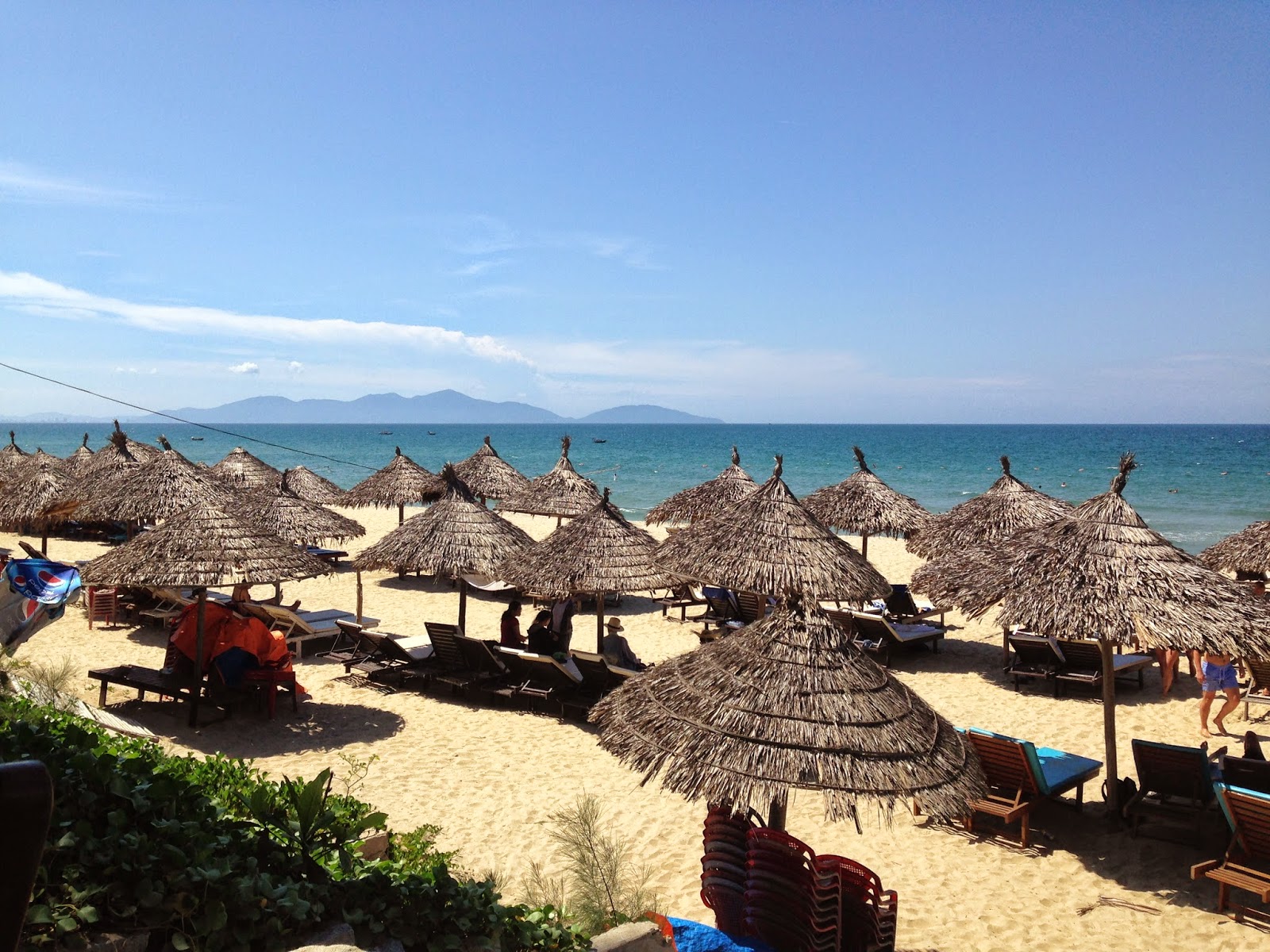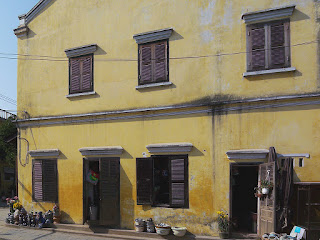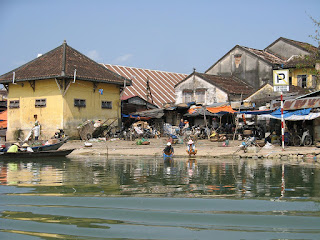Hội An: Ancient Town, Lovely Beach, Magic Atmosphere
Beaches, textiles, cacti, seafood, and old, old, old buildings are just a few of the pieces of the puzzle called Hội An - one of the oldest, and most immaculately preserved, trading port towns existing in SE Asia today... and definitely one of the most unique.
In July 2014 I visited with my good friend Lisa, after spending several (extremely mild) days in beautiful Da Lat and a bit in Saigon. It was only 700 km from the south-central highlands to this central port town, but the weather couldn't have been more different! We got a lot of variation on our trip together - a key characteristic of Vietnam.
Da Lat required me to buy a sweatshirt and scarf (a scarf, people), but there was zero need for them here. Although it was the beginning of the rainy season, we were blessed with three days of beautiful, hot, sunny days, and we took advantage of each one to the fullest, eating, drinking, biking, and walking our way around this sleepy and beautiful town.
 |
| This is outside the Ancient Town, but within Hội An. That is a Happy Cow! |
Hội An is a relatively small city (120,000, counting the whole town and
not just the Ancient Town portion, which includes a fairly large amount
of rural space and agriculture) on the central coast of Vietnam, about
25 km south of the Center's most metropolitan and modern city, Da Nang.
It was relatively untouched by tourism prior to the mid-nineties - that
has certainly changed. Today, both Vietnamese and foreigners from all
over the world pour into Hội An from the Da Nang Airport to relax, shop,
and experience a truly unique site that also doesn't skimp on the
authenticity or entertainment... and in some places, outright luxury.
 |
| TWO-FER SHOT: Tailoring + Lanterns. |
It was designated a UNESCO World Heritage Site in 1999, and since then their economy has blown up in a major way. The port itself is used for both tourism and fishing, but, much like other Vietnamese hotspots, tourism has not put a dent in traditional methods of earning a living. Conservative Vietnamese culture is hesitant to ever put all its eggs in one basket, to say the least, and although the number of families depending on tourism is statistically significant, there are thousands more for whom the exploding tourism industry is only a local sideshow.
 |
| This plaza hosted theatre at night - but my poor iPhone camera does NOT like lantern light so much. Also... no idea what was going on. Didn't watch much. |
The downtown ('Ancient Town') is extremely well-preserved and virtually
untouched. It has banned motorbikes in the morning and evenings,
allowing only pedestrians and bicycles. It makes for an exceptionally
strange experience - not having to dodge 'bikes lends a sleepy, lazy
kind of feel to the district in the morning, and a block-party
atmosphere after dark (around 6pm).
 |
| Pants. Pants everywhere. So cheap. |
There is also the Museum of History and Culture, the Museum of Trade Ceramics, and the Museum of Sa Huỳnh Culture, all of which I'm sure are quite academically interesting and probably (definitely) would have made my eyes glaze over. A man can only take so many history museums, let's be honest. Hopefully next time I visit (if that happens) I'll be in the mood to learn more about the ancient Champa culture, and the various regional influences on the city.
 |
| It's the most relaxed block-party in Vietnam - Ancient Town, bumpin' pubs, never-ending street donut paradise. |
 |
| UNESCO rules and township ordinances preserve the structures in Ancient Town, most of which are variations on this theme - wooden, red, and gold. |
Fortunately, that means touristy for Vietnamese, too, which means traditional street theatre, performers, donut stands (oh my god, the donut stands!), street food of all kinds, and unique experiences like sending candles down the river in little paper boat things. Watching small flames in all different colors float downstream from the main pedestrian bridge was a magical sight, and lent an ethereal feeling to the shores, blazing with a thousand lanterns of every conceivable color.
The crowds at night were initially overwhelming, but it was simply tired
nerves our first night exploring that made me go NUH UH. The next night
was much better, and we found a less intense route. Being able to walk
through the downtown, stopping in for a drink or ice cream, and then
moseying on is a dream!
 |
| Lanterns! All shapes, sizes, colors, designs, and materials!! |
 |
| A mid-morning cafe in traditional colors. |
Outside of the Ancient Town portion of Hội An, there are long walks, a billion more tailors and cobblers (and everyone you meet has a place their relatives run and it's simply the best in town, but hurry they're so good they need you to come right now today), many, many temples, beautiful outlying districts, rice paddies and vegetable farms, and two really nice beaches with some fantastic swimming areas.
One bizarre thing we saw on our walk to An Banh beach the second day, something I never expected, was an abundance of cacti. Most of them looked like this:
We took a bunch of pictures in a desolate graveyard off a main road,
halfway between two fields. There was a half-finished temple in the
background. It was also apparently a bathroom (technically, I guess
anywhere along the side of the street in Vietnam is a bathroom), as we
saw a busload of Vietnamese stop off for a pee break while we were
snapping pics of the graves and cacti.
An Bang beach was the first of the two beaches we visited. I said goddamn. More beach time, please!
 It
wasn't as ritzy as the resort at Mui Ne, but it wasn't as insanely
crowded as the beaches at Vung Tau, either. We weren't there for a
weekend, which probably helped, and it was a lovely, relaxing time. We
took turns splashing around in the waves and sunbathing/sunburning until
we'd had enough for the day, eating a little rice now and then and
waving off the many beach vendors with trinkets.
It
wasn't as ritzy as the resort at Mui Ne, but it wasn't as insanely
crowded as the beaches at Vung Tau, either. We weren't there for a
weekend, which probably helped, and it was a lovely, relaxing time. We
took turns splashing around in the waves and sunbathing/sunburning until
we'd had enough for the day, eating a little rice now and then and
waving off the many beach vendors with trinkets.We rented a bike for one of our days in Hội An, and it was a much cooler way to get around than walking. There's nothing like making your own breeze to pretend you're not sweating your face off! Our small tour took us round one of the islands off the mainland, and we got to see many small temples, as well as the regular assortment of houses and shops.
We also found some parking and walked around the Market, still housed in the original structure but now extending down side streets in most directions. Lots and lots of t-shirts, table runners, lanterns, trinkets, and other touristy things were available, as well as anything you'd find in any local market - fresh seafood and meat, produce, rice, bread, office supplies, etc.
Additionally, we discovered an entire market building devoted to textiles, but had to leave relatively quickly... as soon as we walked in we were besieged by vendors trying to get us to step into their 'shop' and get some clothes made on the spot. No picture-taking happened here - we were too anxious to get away from the sales pressure!
The structures in the Ancient Town portion inevitably exhibit influences from the various cultures and religions that have utilized this site as an essential trading port for the last 500 years. Chinese meeting halls are in evidence, as well as buddhist temples of all varieties. They are not just relics - these are functioning meeting places and houses of worship, and upkeep seems to be ongoing and contemporary.
I've saved the icon of Hội An for last. This is a shot of the covered Japanese bridge - 500 years old and still standing! It's the only example of its kind in the world that has a Buddhist temple attached to it (and it's over the river portion! Very cool).
 |
| Begun in the year of the dog, finished in the year of the monkey. No moto allowed! |
 At
certain points during Hội An's history, the town was segregated, with
Japanese traders and business families living on the Western side of
this bridge, and Vietnamese, Indian, Chinese, and Dutch (yes, even
Dutch!) on the Eastern side. The bridge itself is remarkably intact, and
lends its profile to the official badge of the city.
At
certain points during Hội An's history, the town was segregated, with
Japanese traders and business families living on the Western side of
this bridge, and Vietnamese, Indian, Chinese, and Dutch (yes, even
Dutch!) on the Eastern side. The bridge itself is remarkably intact, and
lends its profile to the official badge of the city.Overall, this was an utterly remarkable portion of Vietnam to visit, and I'm glad Lisa convinced me! There were a variety of unique meals we had here (which will be detailed in a post about veggie Vietnam) and the ambiance, atmosphere, and sights were unique to my experience so far. Far from Da Lat and Ho Chi Minh City, this showcased a different variety of Vietnamese experience, and one that is sure to continue changing - outside of Ancient Town - to cope with new challenges such as rapidly increasing tourist loads as well as climate change.



































Không có nhận xét nào:
Đăng nhận xét
Lưu ý: Chỉ thành viên của blog này mới được đăng nhận xét.